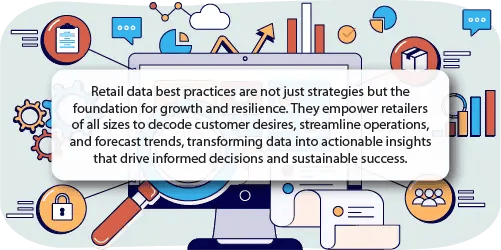Since retail data informs and dictates long-term success, mid-sized retailers stand at a crossroads. Adopting retail data best practices is not merely beneficial - it's imperative for those aiming to carve out a significant space in the market. These strategies are the key to unlocking customer satisfaction, operational efficiency, and growth, offering a beacon through the complexities of today's retail challenges.

Why prioritize retail data best practices? Data offers the key to understanding and meeting consumer desires. By harnessing this invaluable resource, retailers can predict trends, tailor services, and enhance satisfaction, creating a loyal customer base and distinguishing themselves in a crowded market. The strategic use of data propels them forward and transforms challenges into opportunities for growth.
How do retailers implement these data best practices effectively? It begins with integrating diverse data sources for a comprehensive view, employing advanced analytics for deep insights, and establishing robust feedback mechanisms for continuous improvement. This foundation paves the way for leveraging retail data to meet and exceed customer expectations.

Centralize all data collection efforts
Data acts as both a compass and a map for retailers, guiding strategic decisions and charting the course to customer satisfaction and operational excellence. However, the challenge lies not in collecting data but in harnessing it from multiple sources - from in-store sales and online shopping behaviors to social media interactions and loyalty programs.
Centralizing data collection emerges as a pivotal strategy for retailers eager to unlock the full potential of this information goldmine.
Gathering data from diverse sources
The journey towards a centralized data approach begins with collecting data from every customer touchpoint.
Consider Walmart's strategy of leveraging both its physical stores and online platforms. This dual-channel data collection enables Walmart to tailor product offerings and marketing strategies, meeting customer needs across all shopping experiences.
Beyond these traditional sources, tapping into social media feedback and in-store traffic patterns can unveil deeper insights into consumer preferences and behaviors, offering a more rounded view of the retail landscape.
Tools and platforms that ensure data integration
Integrating disparate data into a single platform can pose significant challenges, from data format standardization to ensuring data quality. Platforms like Salesforce and Oracle offer robust solutions that consolidate data from diverse sources into one accessible hub.
Similarly, DotActiv caters specifically to the needs of market segments, highlighting the importance of choosing a platform that aligns with a retailer's specific requirements.
For example, Starbucks' use of CRM tools to analyze customer data across its global network exemplifies how it can achieve personalized marketing and enhanced customer loyalty through strategic data integration. In South Africa, retailers such as Food Lover's Market, Makro, and Ultra Liquors utilize these technologies to navigate their unique market dynamics.
Benefits of a unified data platform
Adopting a unified data platform offers a plethora of advantages. It provides a holistic view of the business, allowing retailers like Target to use predictive modeling for optimizing inventory levels - significantly reducing the risk of stockouts and overstocks. More importantly, it simplifies decision-making processes, enabling quick adjustments to market changes and consumer needs.
Centralized data collection empowers retailers to make informed decisions, enhances customer satisfaction, and secures a competitive edge in an increasingly digital marketplace. By embracing the right tools and platforms for data integration, retailers can transform their data into actionable insights, driving growth and innovation.
This strategic focus on centralizing data collection sets the stage for a deep dive into the subsequent best practices, equipping retailers to leverage their data for maximum impact.

Implement advanced analytics
Navigating the vast landscape of analytics can be daunting. Yet, implementing advanced analytics is a cornerstone for unlocking deep insights into customer behavior, optimizing inventory, and crafting effective marketing strategies.
Advanced analytics, encompassing predictive modeling, machine learning, AI-driven insights, and more, go beyond traditional data analysis to anticipate future trends and behaviors.
Analytics tools and software
Advanced analytics tools like Tableau, Microsoft Power BI, and DotActiv are increasingly accessible and offer insights without extensive IT resources.
These platforms can aggregate data across sales channels, customer interactions, and inventory levels to provide a comprehensive view of retail operations.
For example, Makro utilizes advanced analytics to analyze sales trends and customer feedback, enabling rapid adjustments to production and inventory in response to changing trends.
Gaining insights from data
The insights derived from advanced analytics can significantly impact a retailer's strategy.
For example, retailers can identify buying patterns and preferences by analyzing customer purchase history and online behavior.
Amazon's recommendation engine exemplifies this, using past purchases and browsing data to suggest products, which enhances customer engagement and drives sales. This level of personalization not only improves the shopping experience but also solidifies customer loyalty.
Analytics in action
Using analytics for inventory management can lead to more efficient operations.
Nordstrom, for example, uses analytics to balance inventory levels across its stores and online, reducing stockouts and markdowns. In marketing, analytics can identify which campaigns are most effective, as seen with any targeted email campaigns from prominent retailers, refined through ongoing analysis of customer engagement metrics.
Finally, in customer service, analytics can help retailers understand common issues and sentiments, which enables proactive improvements. Apple, for example, analyzes customer feedback from various channels to refine its in-store experience.
Implementing advanced analytics allows mid-sized retailers to make informed decisions across every aspect of their operations, from inventory and marketing to enhancing the customer experience. With the right tools, retailers can turn data into a strategic asset, driving growth and customer satisfaction in a competitive landscape.

Enhance the customer experience
Personalization is not just a luxury but an expectation of shoppers. Retailers equipped with the right data strategies can craft shopping experiences that are not only relevant and engaging but also secure, elevating customer satisfaction.
Personalize all customer interactions
The key to personalization lies in the nuanced use of data to tailor interactions to each customer's unique preferences.
Take Netflix as an example; it uses viewing history to personalize recommendations, significantly enhancing user satisfaction. Retail giants like Nike take this further, customizing product suggestions and marketing communications based on purchase history and online behavior.
For retailers, adopting CRM systems integrated with AI and machine learning can offer similar personalization capabilities, making sophisticated marketing strategies accessible without the need for extensive tech resources.
Maintain data privacy and security.
As digital footprints expand, consumer demand for privacy and security intensifies. Compliance with data protection laws, such as GDPR, and adopting robust security measures like encryption and anonymization are indispensable.
Apple's approach, prioritizing user consent and minimal data use, exemplifies how to personalize without breaching trust. Retailers must emphasize transparency in their data practices, fostering a relationship of trust that enhances the customer experience.
Strategies for customer loyalty and retention
Beyond personalization, data is instrumental in cultivating deep customer loyalty.
Starbucks’ rewards program is an excellent example. By analyzing purchase data, Starbucks offers personalized rewards that encourage repeat business and increase customer loyalty. Similarly, Sephora’s Beauty Insider program leverages customer feedback to customize rewards and experiences, significantly enhancing engagement.
Mid-sized retailers can draw inspiration from these examples, starting with more straightforward loyalty schemes and using available analytics tools to understand customer preferences and behaviors.
Implementation insights
While leveraging data for customer experience enhancement is promising, retailers may encounter challenges like data silos and the complexity of data analysis. Solutions include investing in integrated data platforms and prioritizing staff training in data literacy. Starting with a focused approach - perhaps enhancing personalization in email marketing or refining a loyalty program based on customer purchase data - can yield immediate benefits and serve as a foundation for broader initiatives.
Enhancing customer experience through data is a multifaceted approach encompassing personalization, privacy, and loyalty strategies. By focusing on these areas, retailers can meet and exceed customer expectations, fostering a sense of value and belonging that keeps customers returning.

Continually monitor and make improvements
Staying ahead in retail requires a commitment to continuous monitoring and improvement. Retailers can navigate market changes and remain competitive by leveraging key performance indicators (KPIs), advanced dashboards, and feedback loops.
This strategic approach ensures operations are both efficient and aligned with consumer expectations.
Set up Key Performance Indicators
The foundation of any data-driven strategy is the effective use of KPIs. Retailers must identify those metrics that reflect their business goals, customer satisfaction, and operational efficiency.
Beyond sales growth and inventory turnover, incorporating metrics like online engagement, Net Promoter Score (NPS), and return rates offers a holistic view of performance.
IKEA, for example, adopts sustainability KPIs, monitoring the percentage of products made from renewable materials to align with its eco-friendly business model. Tailoring KPIs to specific segments of retail operations ensures a focused strategy that can adapt to changing consumer behaviors and market trends.
Use retail dashboards and reporting tools
Real-time dashboards and reporting tools are invaluable for retailers.
A platform like that provided by DotActiv offers insights into performance across various categories, enabling swift strategic adjustments.
The goal is to transform data visualization into actionable insights, necessitating data literacy among staff bolstered through training and hiring analytics experts.
Refine and optimize with feedback loops
Incorporating feedback loops into retail operations facilitates ongoing refinement and optimization.
Retailers like Zappos excel by continuously analyzing customer and employee feedback, ensuring their offerings meet market demands.
Expanding feedback sources to include suppliers and partners and employing technologies for feedback collection - such as customer surveys and social media listening tools - enhances the quality of insights gathered. This comprehensive feedback mechanism supports a dynamic, responsive retail strategy.
Embrace continuous innovation
The future of retail lies in continuous innovation driven by data insights. A culture that values data-driven decision-making encourages contributions from all organizational levels, fostering an environment ripe for ongoing improvement.
By setting precise KPIs, leveraging advanced dashboards, and instituting robust feedback loops, retailers can ensure their strategies are proactive and responsive. In doing so, they can meet current market demands and be well-positioned to anticipate future trends, thus securing a competitive advantage.
Conclusion
Embracing retail data best practices transforms challenges into opportunities, propelling retailers toward success. Meanwhile, failure to implement them means the opposite - retailers risk falling behind, which is fatal in a data-driven market.
Are you looking for software to help you get the most out of your data? DotActiv Enterprise has all the features and functionality you need. Download your trial of DotActiv Enterprise and try it for free for 14 days.


